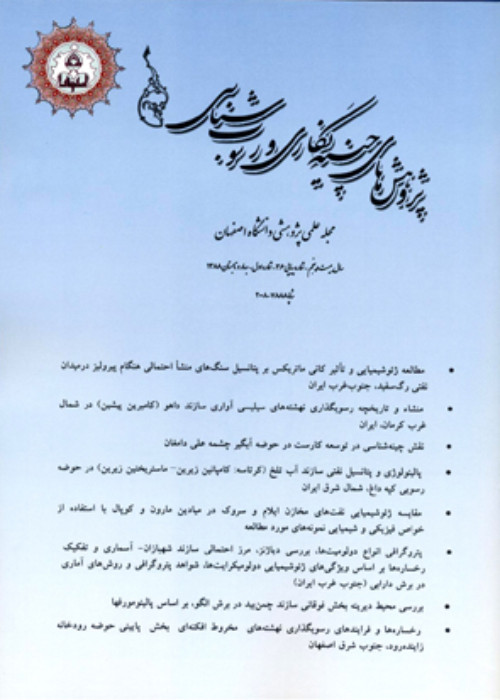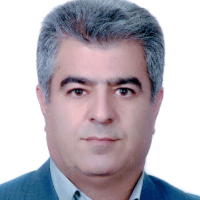Stratigraphic position and diversity occurrences of basic alkaline igneous rocks in the Permian sedimentary strata, Central Alborz Zone
Author(s):
Article Type:
Research/Original Article (دارای رتبه معتبر)
Abstract:
Abstract
A completely lithologic sequence of Permian strata including Doroud (mainly of sandstone and shale), Ruteh (mainly of limestone with interbed marl) and Nesen (mainly of limestone and shale) formations is exist in Central Alborz zone from Siyah-Bishe and Harijan in Chalous Road to Yoush, Baladeh, Zarin-Kamar and Varazan in south of Amol in Mazandaran Provence. Based on the field geology and petrography, these igneous rocks with basic alkaline nature are found as dike, sill and small diabasic, micro-gabbroic and lamprophyric intrusions in the Doroud Formation and as basaltic lava flows and related pyroclastics in the upper part of Ruteh Formation. In fact, low-depth microgabbroic and lamprophyric intrusions in the Doroud Formation were residual and solidified melt in feeding vents of the basaltic volcanism in the upper part of Ruteh Formation. Doroud Formation was deposited in a Fluvial- Deltaic environment in Early Permian, Ruteh and Nesen formations were deposited in carbonate platform (lagoon, barrier and open marine) in Middle–Late Permian respectively. Lack of continues reefal facies and turbiditic sediments indicate that the Routeh and Nesen carbonate formations deposited in a carbonate ramp platform. At this time, the central Alborz was as a passive margin in the south side of the Paleo-Tethys and its alkaline basic magmatic activity is interpretable with the Late Paleozoic extensional tectonics in the north side of the Gondwana and simultaneously with initial stages of Neo-Ttethys development in Zagros.
Introduction
According to Berberian and King (1981), Paleozoic magmatic activity has not been extended in Iran, but the study of these rocks is a very important key to better understanding the geological events of this period in Iran and adjacent countries. For example, the opening time of the Paleo-tethys and Neo-tethys oceans need to understand their geologic events (such as magmatism and metamorphism) in the Paleozoic era. One of the most widespread events is the magmatic activity of the Ordovician–Silurian in the Eastern Alborz (Sultan Meydan Complex), which can be certified on the occurrence of extensional tectonics in the early stages of opening of the Paleo-Tethys ocean (Ghasemi and Khanalizadeh 2012; Ghasemi and Kazemi 2013; Derakhshi and Ghasemi 2013, 2014; Derakhshi et al. 2014, 2015; 2017). Then, other magmatic phases have been occurred in the Devonian (Ghasemi and Dayhimi 2015; Dayhimi 2012; Derakhshi and Ghasemi 2013, 2014), Carboniferous (Naderi et al. 2018a,b) and especially in Permian (Berberian and King 1981; Vahdati Daneshmand 1991,1999; Saidi and Ghasemi 1991; Gaetani et al. 2009; Delavari et al. 2017; Rostami et al. 2018). The discussions and views on the place of Iran during Permian and the closure time of the Paleo-Tethys ocean and opening of the Neo-Tethys ocean reveal the importance of the Permian magmatism. After Permian, with developing of the Neo-Tethys ocean, some parts of Iran (such as Central Iran and Alborz), as the Cimerian territories, were separated from the north of Gondwana and moved to the northern Eurasia super-continent (Gaetani et al. 2009). With the closure of the Paleo-Tethys ocean at the Early Jurassic (Boulin 1988) or the Late Triassic (Stöcklin 1974; Alavi et al. 1997; Stampfli and Borel 2002; Horton et al. 2008; Wilmsen et al. 2009; Zanchi et al. 2009), which is characterized by the Eocimerian discontinuity in Alborz, the connection of the cimerian microcontinent to southern Eurasia have been occurred. Thus, over the Middle to the Late Permian, the cimerian territories embedded between the two oceanic zones, the newly emerging Neo-Tethys in the south (Zagros) and the destroying Paleo-Tethys in the north becoming closer to Eurasia (Stampfli et al. 2002; Nikishin et al. 2002; Gaetani et al. 2009; Berra and Angiolini. 2014; Domeier and Torsvik 2014). The Permian–Triassic extentional phase is one of the most important rifting phases in Iran, indicating the opening of the Neo-Ttethys oceanic basin whose signs are found as basaltic magmatism in Alborz and other parts of Iran (such as Central Iran and Sanandaj–Sirjan) (Berberian and King 1981; Ghaesmi and Jamshidi 2012; 2013; Ghasemi et al. 2018). The studied area is located in northeastern Baladeh (Central Alborz) from Siyah-Bishe and Harijan on Chalous road to Yoush, Baldeh, Zarrin Kamar and Varazan in south of Amol in Mazandaran province. It contains sedimentary units of Permian (Doroud, Ruteh and Nessen formations), along with igneous basic alkaline rocks (volcanic and intrusive). Main spreading of volcanic rocks in the Baladeh area has been reported between the Ruteh and Nessen formations (Vahdati Daneshmand 1991,1999; Saidi and Ghasemi 1991; Delavari et al. 2017; Rostami et al. 2018), but based on the findings of this research and in according to Gaetani et al. (2009), these magmatic rocks are located not between the Ruteh and Nesen Formations, but in the form of intrusive bodies in the Doroud and the lower part of the Ruteh formations, and in the form of extrusive and pyroclastic rocks in the upper part of the Ruteh Formation. The intrusive bodies that were originally solidified magma in the feeding vents of volcanic rocks widely cropped out in the form of dikes, sills and small diabasic, microgabbroic and lamprophyric intrusions in the Doroud Formation and in the lower part of the Ruteh Formation in Siyah-Bishe and Harijan on the Chalous road and are not mentioned in any previous studies. In addition, lamprophyric dikes are also reported in the region for the first time in this study.
Material and Methods
The systematic study of the Paleozoic igneous events of the Alborz region (Ghasemi and Khanalizadeh 2012; Ghasemi and Kazemi 2013; Derakhshi and Ghasemi 2013; 2014; Derakhshi et al. 2014, 2015; 2017; Dayhimi 2012; Naderi et al. 2018a; b) and northeastern Iran around Mashhad (Li et al. 2018; Mobasheri et al. in press) and their use to study the evolution of the Paleo-Tethys ocean needs to studying and precision field surveying, petrography, mineral chemistry, as well as precise chemical analysis of major, minor, trace and rare earth elements of whole rocks, and even isotopic analysis and age dating from the Permian igneous specimens of Central Alborz. But, due to the variety of topics, the large amount of the data and processing and interpretation, this paper only refers to the precise stratigraphic position, diversity occurrences of igneous rocks, geological relations and their geomodynamic significance in the analysis of the evolutionary trend of the Alborz Basin during the Permian period. Studies and field sampling were carried out in all Permian outcrops of the region, using previous research data and tracking these rocks in high-resolution satellite images of the area, as well as performing via precise cross-sectional surveys in the available outcrops in a systematic and selective manner. Preparation of thin sections and their petrographic studies have been carried out in the laboratories of the Faculty of Earth Sciences, Shahrood University of Technology.
Discussion of Results and Conclusions
A completely lithologic sequence of Permian strata including Doroud (mainly of sandstone and shale), Ruteh (mainly of limestone with interbed marl) and Nesen (mainly of limestone and shale) formations is exist in Central Alborz zone from Siyah-Bishe and Harijan in Chalous Road to Yoush, Baladeh, Zarin-Kamar and Varazan in south of Amol in Mazandaran Provence. Based on the field geology and petrography, these igneous rocks with basic alkaline nature are found as dike, sill and small diabasic, micro-gabbroic and lamprophyric intrusions in the Doroud Formation and as basaltic lava flows and related pyroclastics in the upper part of Ruteh Formation. The intrusive rocks show ophitic, subophitic, poikilitic, poikilophitic, microlitic porphyry, intergranular and microgranular textures composed of olivine, clinopyroxene, plagioclase and amphiboles as the main minerals. The extrusive rocks show amygdaloidal, hyalomicrolitic porphyry, microlitic porphyry, hyaloporphyry, intersertal and trachytic textures composed of olivine, clinopyroxene and plagioclase as the main minerals. The amigdals filled by secondary minerals such as calcite, chlorite and quartz. Compositional zoning and sieve texture in clinopyroxene and plagioclase and skeletal texture and corrosion of crystal margins in olivine and clinopyroxene are widely seen. In fact, low-depth microgabbroic and lamprophyric intrusions in the Doroud and the lower part of the Ruteh formations were residual and solidified melt in feeding vents of the basaltic volcanism in the upper part of Ruteh Formation. According to Delavari et al. (2017) and Rostami et al. (2018) Permian magmatic rocks of the Baladeh area have sodic alkaline nature and are derived from crystallization of a basaltic melt originated from partial melting of an Oceanic Island Basalt (OIB) source in a within plate tectonic setting (a deep garnet bearing mantle source of HIMU type). This tectonic setting can be the result of the extensional tectonics prevailing of the Middle–Late Permian, which is accompanied by pressure reduction on the mantle, rising the deep mantle plume, melting it at high depths, and formation of the basaltic magma. This extensional regime coincided with the early stages of crust uplifting and formation of the rift basins as a prelude to the formation and evolution of the Neo-Tethys Ocean in the southern part of the Paleo-Tethys. The geodynamic rearrangement of the Tethys realm during the Late Paleozoic–Early Mesozoic, has been accompanied by magmatic activity along the northern margin of Gondwana from the east of the Himalaya to Tibet, Oman, Iran and Turkey (Zhu et al. 2010). From the petrographic data and the chemical analysis of igneous rocks, along with the evidence of stratigraphy, facies and sedimentary environments can be used to determine the tectonomagmatic setting and the paleogeography of the Alborz land during Permian. Accordingly, Doroud Formation was deposited in a Fluvial-Deltaic environment in Early Permian, Ruteh and Nesen formations were deposited in a carbonate platform (lagoon, barrier and open marine) in Middle–Late Permian respectively. Lack of continues reefal facies and turbiditic sediments indicate that the Routeh and Nesen carbonate formations deposited in a carbonate ramp platform. At this time, the central Alborz was as a passive margin in the south side of the Paleo-Tethys and its alkaline basic magmatic activity is interpretable with the Late Paleozoic extensional tectonics in the north side of the Gondwana and simultaneously with initial stages of Neo-Tethys development in Zagros.Keywords:
Language:
Persian
Published:
Stratigraphy and Sedimentology Researches, Volume:34 Issue: 4, 2018
Pages:
1 to 20
magiran.com/p2006600
دانلود و مطالعه متن این مقاله با یکی از روشهای زیر امکان پذیر است:
اشتراک شخصی
با عضویت و پرداخت آنلاین حق اشتراک یکساله به مبلغ 1,390,000ريال میتوانید 70 عنوان مطلب دانلود کنید!
اشتراک سازمانی
به کتابخانه دانشگاه یا محل کار خود پیشنهاد کنید تا اشتراک سازمانی این پایگاه را برای دسترسی نامحدود همه کاربران به متن مطالب تهیه نمایند!
توجه!
- حق عضویت دریافتی صرف حمایت از نشریات عضو و نگهداری، تکمیل و توسعه مگیران میشود.
- پرداخت حق اشتراک و دانلود مقالات اجازه بازنشر آن در سایر رسانههای چاپی و دیجیتال را به کاربر نمیدهد.
In order to view content subscription is required
Personal subscription
Subscribe magiran.com for 70 € euros via PayPal and download 70 articles during a year.
Organization subscription
Please contact us to subscribe your university or library for unlimited access!



